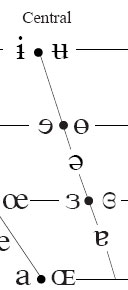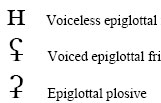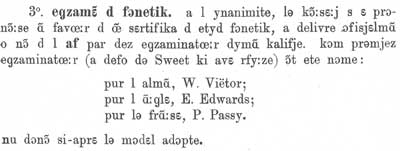DEPARTMENT OF SPEECH, HEARING & PHONETIC SCIENCES UCL Division of Psychology & Language Sciences |
 |
John Wells’s phonetic blog archive 16-29 February 2008To see the IPA phonetic symbols in the text, please ensure that you have installed a Unicode font that includes them all, for example Lucida Sans Unicode or Charis SIL (click name for free download). Browsers: I recommend Firefox (free) or, if you prefer, Opera (also free). email: |
|
Friday 29 February 2008 | Intonation idioms in the Germanic languages (ii)Following on from yesterday... (ii) Apparently predictable words. The nucleus, we know, goes on the last item that adds new information. That’s where the focus domain ends. If we’re in England and you ask me how much, say, a computer costs, you know that the answer will involve pounds: the name of the currency is part of our shared knowledge rather than truly new information. So it is rather illogical that by default we nevertheless accent pounds. You would expect that the name of the currency, being already known, would be out of focus. Yet in a broad-focus answer we use the pattern It costs four hundred 'pounds, rather than the apparently more logical It costs four 'hundred pounds. (The latter is of course also available if we want to narrow-focus on the exact number). It’s the same in German: Es kostet sechshundert 'Euro. And it’s the same in Swedish: Den kostar tjugo 'kronor. Other examples of the same sort of thing include It’s a lovely 'day = Es ist ein wunderschöner 'Tag = Vilken härlig 'dag! (but we both know that it’s daytime); She’s a beautiful 'girl = Sie ist ein schönes 'Mädchen (but we know she’s a girl); It’s seven o’'clock = Es ist sieben 'Uhr. (I haven’t checked the last two in Swedish.) I suspect that this pattern and yesterday’s are common to all the Germanic languages, and would accordingly expect that they are also found in Danish, Norwegian, Icelandic and Faroese. They may well also extend further afield. The BBC website currently has some video clips of Prince Harry being interviewed. This provides an excellent exemplification of the RP (?) spoken by upper-class young men of his age (early twenties). He has extensive t-glottalling (quite a lot kwaɪʔ ə lɒʔ) and l-vocalization (well, people, April weo, piːpo, eɪpro), including remarkable pronunciations of multi-tasking and pulled, in which where I would have ʌl, ʊl he has something like oː for both. Hurry: I don’t suppose it’ll be on the website for long. |
|
Thursday 28 February 2008 | Intonation idioms in the Germanic languages (i)There are some arbitrary or illogical intonation patterns in English that are also found in German and Swedish. Here is one. We’ll have another tomorrow. Wh — be — pronoun. My Japanese colleagues tell me that their advanced students of English are surprised at the usual English tonicity in questions like What 'is it? Where 'am I? Logically, they feel, the focus ought to be not on the verb to be but on the interrogative, the wh word. But in English that would happen only in a pardon question: (What 'is it? — It’s a 'slurge.) — /What is it? or, more likely, — It’s a /what?. My only explanation of the pattern What 'is it? is that it is idiomatic, and something we can’t really explain logically. It is, however, found also in German: Was 'ist es? Wo 'bin ich? (but as pardon questions /Was ist das? Das ist /was?). And in Swedish: Vad 'är det? Var 'är jag? In each language, however, if this kind of sentence ends in a demonstrative rather than a personal pronoun, the nucleus may go in the expected place, namely on the demonstrative: What’s 'that? Was ist 'das?. Or it can stay on the verb: What 'is that? Was 'ist das?. (Thanks to Christopher Bergmann for the German and to Gunnel Melchers for the Swedish.) |
|
Wednesday 27 February 2008 | An impossible soundIn the 1949 edition of The Principles of the International Phonetic Association one of the IPA symbols listed is ʞ, defined as standing for a velar click. This definition is repeated in the current Unicode standard, where ʞ, code point U+029E, LATIN SMALL LETTER TURNED K, is glossed as ‘proposed for velar click’. The Unicode Standard continues, ‘withdrawn by IPA in 1970’. Correct, though I suspect the date is wrong. In fact ʞ had disappeared from the IPA Chart by 1951, though not from the Principles booklet. And why was this symbol dropped? One answer is that no language had been found to have the velar click as one of its sounds. But the real reason is that a velar click is anatomically impossible. By the 1960s we understood non-pulmonic airstreams better than our predecessors did. We knew that clicks are made with an ingressive velaric airstream mechanism, involving a closure between the back of the tongue and the velum (as in k). Since this closure is used to separate off the mouth cavity from the pharynx ready for initiation of the air flow, it cannot simultaneously be used for a velar velaric articulation. As well as the velar closure, clicks must have some closure forward of the velar place, involving therefore the front/blade/tip/side of the tongue or the lips. Muscular expansion of the cavity between the two closures provides the suction needed to make a click on release. What you can have simultaneously with a click is a velar articulation involving a non-velaric airstream mechanism, typically a pulmonic one. That is why clicks can be nasal (simultaneous ŋ rather than k), voiced (simultaneous ɡ), etc. Indeed, one way of checking that a sound is a click is to see whether you can do ŋ simultaneously with it: if you can, it’s a click. As Pullum and Ladusaw put it in their discussion of ʞ (Phonetic Symbol Guide, University of Chicago Press, 19962, p. 101), The IPA’s recommendation was simply a mistake, and the symbol could never be validly used. It was dropped from the IPA chart with the 1979 revision. Ladefoged’s website has a ciné x-ray of a real click, a dental one. | ʞ |
Tuesday 26 February 2008 | Aught of artStuart Whyte, the first person to contact me using the new Ask Professor Wells button on my home page (what a hostage to fortune that is!) writes: I read recently that the following sentence has the 14 vowel sounds of English within it: - This sentence is quite often used by teachers of speech and drama. I replied I don't know, but it seems definitely to belong in the Victorian era. It is quoted in Greene 1972 The Voice and its Disorders and is a sentence that not merely contains 14 vowel sounds, but has the sounds in a particular order (going clockwise more or less round the periphery of the vowel area: i.e. with a gradually rising second formant). It is also of interest that to work properly the sentence requires the speaker to use RP or something similar, with strong forms of would, of, and must, which in ordinary speech are usually weakened, but a weak form of and. As long as we do this, we get the sequence uː ʊ əʊ ɔː ɒ ɑː ʌ æ ɜː ə e eɪ ɪ iː. Now Stuart has found another source. Moulton H H (1936) Your First Class in Oral Expression. The English Journal, Vol. 25, No. 10. (Dec., 1936), pp. 865-867 The addition of high is unnecessary and makes us ask where its counterpart how is. As first quoted, the sentence covers only the monophthongs and narrow diphthongs. To complete it with the remaining diphthongs aɪ aʊ ɔɪ ɪə eə ʊə we would need something like My loud voice nears their moors. Or has someone got something better? |
|
Monday 25 February 2008 | NavajoGlenn Alessi suggests a clip of some spoken Navajo. So here you are: the Navajo for ‘hello’, yá’át’ééh. Listen for the ejective alveolar plosive. |
Friday 22 February 2008 | Anglicized Welsh place namesIn Gwent, southeast Wales, in areas where the English language displaced Welsh centuries ago, there are nevertheless plenty of small villages with names that are obviously Welsh, both in appearance (their spelling follows Welsh spelling conventions) and in meaning (in Welsh they mean something). I wonder how they are in practice pronounced by their monoglot English-speaking inhabitants. Between Chepstow and Newport, for example, just across the border from England, we find villages called Mynydd Bach, Gaerllwyd and Pen-y-cae-mawr (‘small mountain’, ‘grey castle’, ‘top of the big field’). In standard Welsh they would be ˈmənɪð ˈbaːx, ˈgəɪr ˈɬʊɪd, ˈpen ə kəɪ ˈmaʊr. Many of these village names are listed in the recently published Dictionary of the Place-names of Wales by Hywel Wyn Owen and Richard Morgan (Gomer Press 2007), but without any systematic indication of pronunciation. None of them are mentioned in the BBC Pronouncing Dictionary of British Names (OUP, second ed. 1990). Let’s consider the elements of the place names one by one. As an English name, though of Welsh origin, mynydd becomes Mynd mɪnd in the name of the Shropshire hill The Long Mynd. Gaer is the mutated form of caer, which gives us Car kə in Carmarthen/Caerfyrddin and Carnarvon/Caernarfon. Welsh Llwyd becomes English Lloyd lɔɪd. Pen anglicizes with no difficulty; the article -y- becomes English i in for example Pontypool/Pont-y-pŵl, and -cae- gets reduced to kə in Gwaun-cae-Gurwen ˈgwaɪn kəˈgɜːwən. Of course what I ought to be doing, instead of speculating, is going out there and interviewing local people. I don’t have anyone from east Gwent here in London that I can consult, but I do have someone from further west, a lady from near Neath. She says she speaks no Welsh, and indeed remembers from her schooldays that there was only one child in her class who spoke Welsh at home, which made him something of an outsider. (This was before the days of Welsh-English bilingual education.) When I asked her about the village of Blaengwrach, she had no hesitation in pronouncing it as blaɪnˈgraːx. Similarly, she confidently pronounces Llanelli as ɬəˈneɬi. So she clearly has the non-English consonants x and ɬ in her system. She has the usual anglicization of Pontypool with -i-, but pronounces Pontypridd as pɒntəˈpriːð, with Welsh-style -ə-. I asked her about Mynydd Bach. Straight away: ˈmʌnɪð ˈbaːx. So members of the non-Welsh-speaking majority in Wales can often nevertheless pronounce Welsh names in a Welsh, as opposed to an anglicized, way. PS See now Jack Windsor Lewis’s comments. In a sense we’re both right about ɬ: I meant that the lady has this item in her system, distinct from any other consonant phoneme; Jack points out, no doubt rightly, that the version produced by some non-Welsh-speakers (perhaps ɬl or, worse, xl or θl) would not pass muster in a phonetics exam. |
|
Thursday 21 February 2008 | Popular phoneticsIn the Guardian one day last week Sam Wollaston, their television critic, was discussing a programme in which two people had the job of scouting the streets looking for new [fashion] models. He commented, "Model" needs to be pronounced as it is in the industry, with no "l" sound at the end, just a glottal stop instead. I put a comment on the Guardian blog saying Sam says "model" needs to be pronounced "...with just a glottal stop". Other readers chimed in Yes, would be strange to hear "model" end with a glottal stop... Man... isn't it a vocalised 'w'? I left it at that. What was interesting about Sam Wollaston’s original comment was that glottal stop — perhaps the only one of our phonetic technical terms to have become truly popular in the wider world — seems to be being used as a catch-all term for any and every pronunciation feature the writer disapproves of. |
|
Wednesday 20 February 2008 | Dead lettersFrom the IPA exam regulations: In the dictation of nonsense words or an unknown language, candidates should be prepared to recognise any sounds occurring in the IPA chart. Let’s leave aside the interesting question of whether any sounds truly occur in the chart, since on the face of it that seems to betray a naive confusion of speech (sounds) and writing (symbols). Instead, here is something candidates sitting this and other examinations in practical phonetics might like to know. There are a few symbols in the chart that you can ignore. You will not be tested on them. They stand for sounds that you will not actually be expected to recognize or reproduce. Take, for example, the vowel ɞ. In the current IPA chart it is shown as standing for an open-mid central vowel, the rounded equivalent of ɜ. But rightly or wrongly it is simply not among the sounds we drill advanced students on. (Rightly, I think: when did you last see this symbol in use, as opposed to sitting in a chart?) The same applies to ɘ, the symbol for an unrounded close-mid central vowel. You will indeed be tested on the cardinal vowels i e ɛ a ɑ ɔ o u y ø œ ɒ ʌ ɤ ɯ, though probably not on ɨ ʉ ɵ and certainly not on ɶ. (Although there are some quite well-known languages for which one or other of these symbols is needed.) Among the non-cardinal vowels the only ones you must know are the ɪ ʊ æ ɜ ə that you need for RP English, plus the ɐ that you may know from the phonetics of German or Portuguese. As with vowels, so with consonants. You can ignore the ‘other symbols’ ɺ ɧ ʜ ʢ ʡ. Concentrate on mastering the recognition and production of the consonants shown in the main table at the top of the chart, plus clicks, implosives, and ejectives. Even in the main table I think you could probably ignore ʟ, the velar lateral. A few days ago (blog, 13 Feb.) I said that ʚ had been recognized by the IPA in 1989. I was wrong. The symbol in the Chart is its mirror image ɞ. |
|
Tuesday 19 February 2008 | Des accents enfantinsThe other day I overheard a snatch of conversation. A father has just got onto a bus with his two children, a girl aged about five and a boy aged about seven. They sit right at the front of the upper deck of the bus, so they all have a good panoramic window view. The boy takes the seat next to the side window. The girl protests. Girl: \/Daddy, | 'I want to sit on the \window side. If it were me, I think I would have said But you \are on the window side! General principles lead us to say that accenting on would be avoided, since it is a repeated item (it has just featured in the girl’s utterance). Hence, I assume, my immediate reaction that the boy’s command of English intonation was not yet quite adult-like, and that the proper place for the nucleus is somewhere else, namely on are. This is the word that carries the polarity (positive as against negative). We have what Halliday calls a ‘marked positive’ (see my English Intonation p. 135). But on reflection I think this is not the whole story, and that adult native speakers probably could put the nucleus on on, just as the boy did. (/Couldn’t they?) I find it very difficult to put into words what difference, if any, there is between a nucleus on the preposition on and a nucleus on the verb are. We are dealing here with a counterpresuppositional. The girl’s utterance implies that she is not sitting by the window. The boy (deviously, perhaps) challenges this presupposition. And the intonation patterns of counterpresuppositionals are notoriously difficult to explain (p. 183 in my book). Perhaps someone who knows more pragmatics than I do can shed some light. |
|
Monday 18 February 2008 | A hundred years of the IPA CertificateThis year marks the centenary of the setting up of the International Phonetic Association’s Certificate of Proficiency in Phonetics. Here is a scan of the IPA Council’s decision establishing it (m.f. 23:5-6, 1908, p. 67).
So there were three Certificates, one for German, one for English, and one for French. On the following page the m.f. shows a model of the French certificate. The various topics were Dictée phonétique française Most of these topics remain in the examination to this day, though in recent years only the certificate in English has been examined. We still have dictation of English and of nonsense words (words in an unknown language), transcription, reading from a phonetic text, questions on theory. Only reading from an orthographic text and “spoken pronunciation” have been dropped (since many candidates are now native speakers of English). The standard required has always been uncompromisingly high. (The 1908 examiner for English, Ernest Edwards, was appointed to teach phonetics at UCL in 1903. It was he who recommended Daniel Jones as his successor at UCL to carry on his work.) The IPA examination was particularly important at a time when few universities held examinations in the phonetics of foreign languages, or indeed of oral proficiency in general. As this changed, the number of candidates fell. Latterly, though, it has been given an entire new lease of life by the IPA Certificate strand of the UCL Summer Course in English Phonetics, which culminates with sitting the examination. The current IPA Examinations Secretary is Dr Patricia Ashby. Read about it and download sample questions here. |
|
Friday 15 February 2008 | Thou hast, he hathI was brought up as an Anglican and have therefore been familiar since childhood with the Book of Common Prayer and the Authorized Version of the Bible. A consequence of this, I realize, is that the old present tense 2nd and 3rd person singular verb forms (thou givest, he giveth) are part of my linguistic competence — not something learned by study, but part of my everyday knowledge of English. (They are, though, restricted to the liturgical, biblical and archaic-literary registers of the language.) I have come to realize that for many other native speakers of English this is not the case. To begin with I was amazed to hear people stumbling over these forms and coming up with nonsense such as thou giveth or I comest. From the New York Times Digest, Jan 7, 2008 (www.nytimes.com), comment by Paul Krugman: You see, for 30 years American politics has been dominated by a political movement practicing Robin-Hood-in-reverse, giving unto those that hath while taking from those who don’t. No, it’s he/him that hath and those that have. Look. For he that hath, to him shall be given: and he that hath not, from him shall be taken even that which he hath. One consequence of having these forms as a core part of my knowledge of English is that I know that some of them have strong and weak forms in pronunciation. For example, hath has the strong form hæθ and the weak form (h)əθ. Similarly, hast has the strong form hæst and the weak form (h)əst. I find that I use these as naturally as I do the strong and weak forms of has or have. I know that (thou) sayest is ˈseɪ ɪst but (he) saith is seθ. I know a further interesting fact: that for do there are doublets doest – dost and doeth – doth. In each pair the first (ˈduːɪst, ˈduːɪθ) is used as a main verb, the second (strong forms dʌst, dʌθ, weak forms dəst, dəθ) as an auxiliary. OK, if you’re not sure, the rule is
Now I know (si parva licet componere magnis) what it must feel like to be one of the last speakers of an endangered language. |
|
Archived from previous months:
To search my web pages, use this Google search.













